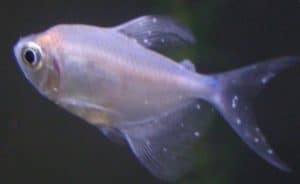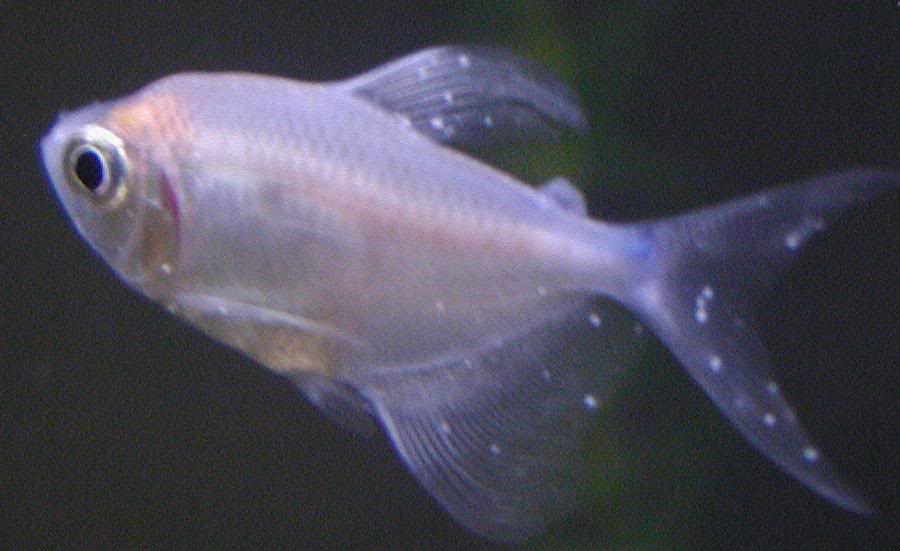 What are these white spots on my fish?
What are these white spots on my fish?
A common ailment we receive calls about is white spots on fish. There are a few potential causes of white spots on fish. The first is a fin ray fracture. This occurs when a fin is damaged and a localized white spot occurs on the fin ray. White spots can also occur with a few fish viruses. Your aquatic veterinarian will determine the cause of the white spots on fish.
In freshwater fish, “Ich,” white spot disease or more formally Ichthyophthirius multifiliis, is one of the most common freshwater parasites. It is a protozoan parasite and can cause 100% mortality if not treated quickly. Unlike some other parasites, only one of these can cause a major problem. As a fish veterinarian, I perform skin and gill biopsies commonly. If I were to see a few Trichodina or monogenean treamatodes (flukes), it is not concerning and does not warrant treatment. However, just one ich parasite can produce over 1000 offspring! This rapid reproduction can overwhelm a system and its inhabitants very quickly. Infections most commonly occur when a new individual is added to a tank/pond and not properly quarantined. Remember, you will save a lot of time, money and lives by quarantining all new fish for 4-6 weeks before adding them to your existing system.
In order to properly diagnose your fish, contact your local aquatic veterinarian.
The White Spot Disease Life Cycle
Ich reproduces through a complex lifecycle. Starting as a trophozoite, the protozoan feeds on epithelial cells of the skin and gills. When it has eaten enough energy, it moves onto an encapsulated phase, called the tomont. This stage is protected by a capsule that adheres to fish, plants, substrate, or anything in your pond. Within the capsule, the tomont divides by binary fission until there are over 1000 theronts, which then break out and become the feeding trophozoites.
How do I treat white spots on fish?
When treating for Ich, you must take its complex life cycle into consideration. Most treatments specific to Ich only treat the free, feeding stage (trophozoite), not the encapsulated form where the parasite divides. Therefore, a two-step or prolonged treatment is required, the length of which depends on the temperature of your system. In 77⁰F water, it takes only 3-6 days for one trophozoite to produce its 1000 offspring. However, at 59⁰F, it takes up to 10 days. The length of time for the life cycle to complete increases the colder the water gets. Keep this in mind while trying to gauge how far to spread apart your Ich treatments.
Most commonly, outbreaks of Ich occur in the spring was the weather starts to warm. Fish stocked at higher densities will develop outbreaks faster since there is more tissue for the trophozoites to feed upon. Clinical signs of Ich are most commonly white spots on the skin and/or gills. Sick fish may show general signs of illness which include sitting on the bottom of their tank, lack of appetite or reddening of the fins. Definitive diagnosis is made by observing the encapsulated form whirling under a microscope. Fish may show signs of flashing (scratching their bodies on objects in their tank) with some bruising along their sides.
There are a few different treatments available, but make sure to remember to treat at least twice or continue treatment for the length of at least 1.5 life cycles. Possible treatments should include formalin, formalin/malachite green, copper or salt. There are many commercial products available to treat Ich specifically. Make sure to check the ingredients so you know what you are adding to your tank. Remember that copper is toxic to ALL invertebrates and salt can kill freshwater plants. For more information on how to diagnose and treat Ich, please contact our hospital at (831) 278-1081.


Pingback: White Spot Disease in Pet Fish - PETS YELPS
Dr. Jessie, what’s fin ray fracture?
A fin ray fracture is when one of the cartilaginous rays that provide the support structure of the fins breaks. It usually creates a localized swelling that easily heals.
How soon should I start seeing results? The treatment I got advises to be used every other day for 7 days.
Please contact your veterinarian for correct treatment instructions. We cannot comment on other veterinarian’s treatment recommendations.
Hi my fish all scratching and noticed one had one clamped Finn but can’t really see any white spots ? Isit possible it could be flukes ?
Please call (831) 278-1081 for veterinary assistance. If you are outside California and Nevada, please visit https://fishvets.org or https://wavma.org.
Hi
Can I still use liquid fertilizer when I treating my tank with ich medication?
Thank you
Amos Chan
It depends on the medication. Please consult with your aquatic veterinarian before starting treatment.